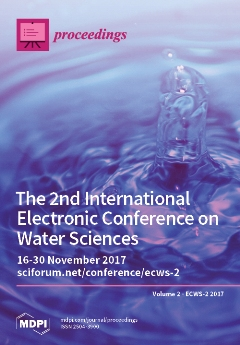Need Help?
Proceedings, 2018, ECWS-2 2017
The 2nd International Electronic Conference on Water Sciences
Online | 16–30 November 2017
Issue Editors:
Maria Filomena Camões, University of Lisbon, Portugal
Kevin B. Strychar, Grand Valley State University, USA
Maurizio Barbieri, Sapienza University of Rome, Italy
Enedir Ghisi, Federal University of Santa Catarina, Brazil
Sunny Jiang, University of California, Irvine, USA
Wilhelm Püttmann, J.W. Goethe University, Germany
Richard Smardon, State University of New York, USA
- Issues are regarded as officially published after their release is announced to the table of contents alert mailing list.
- You may sign up for e-mail alerts to receive table of contents of newly released issues.
- PDF is the official format for papers published in both, html and pdf forms. To view the papers in pdf format, click on the "PDF Full-text" link, and use the free Adobe Reader to open them.
Cover Story (view full-size image):
This issue of Proceedings gathers papers presented at the 2nd International Electronic Conference on Water Sciences (ECWS-2), which cover the following research topics: Environmental Geochemistry;
[...] Read more.
This issue of Proceedings gathers papers presented at the 2nd International Electronic Conference on Water Sciences (ECWS-2), which cover the following research topics: Environmental Geochemistry; Water Quality and Analytical Tools; Rainwater Harvesting in Buildings; Pathogens in Water; Emerging Contaminants in the Water Cycle; Climate Change and Marine Ecosystems and Wetland Research. We would like to thank all attendees for their participation and all conference committee members for reviewing the papers.
Previous Issue
Next Issue
Issue View Metrics
Multiple requests from the same IP address are counted as one view.



